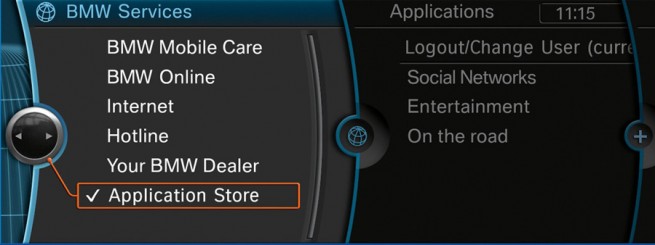At the IAA in Frankfurt (Frankfurt Motor Show) in September 2009 BMW, Nokia and Parrot SA unveiled plans for bringing smart phone applications to cars.
“For software developers, this opens a whole new domain to sell their apps. For car makers, apps provide new ways to deliver infotainment and telematics services to customers. For motorists, apps allow them to enjoy their infotainment systems to the fullest, while paying only for the applications they want, thus saving them money. With apps so critical to the automotive market, companies are pushing approaches that benefit their specific goals. While the solutions shown at IAA were only concepts, they clearly reflect what will soon be on the market.” said Kevin Hamlin, analyst for automotive electronics at iSuppli Corp.
Sounds good? Yes. Where’s the catch? Doing it right!
BMW and its Concept BMW Application Store:
BMW is the first car maker who is opening its own app store: the Concept BMW Application Store. The store offers several different apps and users can download them to their iDrive either directly in their car or via home PC (and then transfer the apps to the car system). The selection of apps ranges from the obvious Facebook, Xing and Twitter to podcasts, web radio, Geowiki, multimedia travel guides as well as various games. I am not sure how big the applications offering is in it’s entirety, but it is a nice step in customizing your car to your needs. Another feature - maybe more useful than the rest and especially for business customers - is the ability to transfer contact data (addresses or phone numbers) to the navigation system or mobile phone connected to the car system.
Locations is also an important part: the apps are able to pull vehicle-related information. BMW has shown apps that draw on information from the vehicle navigation system and even plans to link to other data such as acceleration or braking data. The car’s position is also taken from the navigation system and, if the system is actively guiding the car to a destination, information about the destination time and location can be used.
Nokia, Navteq and Magneti Marelli developing smart car technology:
Nokia, who bought map provider NAVTEQ back in 2007 for around 8 billion (yes, USD), is more looking into mobile device integration with the vehicle rather than introducing apps. During IAA in Frankfurt, Nokia, NAVTEQ, and Magneti Marelli (automotive systems and components specialist) demonstrated a technology which seamlessly integrates smart phones into an in-vehicle infotainment system. Once connected, smart phone features, services and applications can be unlocked and driven through the in-car screens and audio systems embedded in the car. Users would be familiar with the user interface as it would be the same one they see on their smart phones. Through this connectivity, key data such as fuel levels (where is the next gas station), engine status, eco-friendly driving as well as location-based services (coupon for a coffee at a nearby gas station) can be extracted. ADAS (Advanced Driver Assistance System) -based safety features could also be included. For example to warn drivers to slow down for a sharp bend ahead.
“We are happy to be part of this new innovation and looking forward to the new opportunities this technology can bring,” said Vesa Luiro, head of navigation development, Nokia. “The infotainment system of a modern car is a natural extension for the capabilities of smartphones. Not only will it simplify the use of turn-by-turn voice guidance from Ovi Maps, but also provide a new and easy way of accessing other content on the smartphone, such as music and delivering automotive specific widgets from the OVI Store.”
Connection from the mobile device to the infotainment system is made either via Bluetooth or USB cable. This technology known as ”Virtual Networking Computer layer” is in alpha phase and was developed in collaboration with Nokia Research Center, Palo Alto.
Parrot goes open source:
Parrot, a wireless equipment supplier, unveiled an Android-based device (a head unit) that offers automotive implementation of all smartphone features. Great news for Android developers, who do not have to develop on a separate platform for cars. And this also means hundreds of apps are already available.
The head unit itself includes hands-free Bluetooth, A2DP audio streaming, speaker-independent voice recognition, multimedia connectivity, smart track browsing and playlist management, 3G+ Web browsing and 3.0 Wi-Fi and Bluetooth. Also check out Parrot’s Facebook page and Twitter Feed.
App store battle has started - who will win?
As you can see in our Widget and App Store Wiki, a lot of phone manufacturers and operators have already joined the mobile applications battle or are planning their move in this direction. It becomes clear that many other industries such as the book publishers or car manufacturers are trying to get a piece of this cake. I totally agree with gigaom that the key to success in this app store battle will be interoperability. That’s why I think Nokia and Parrot have a the better approach here and BMW’s is a bit short-sighted with their proprietary and apparently closed system.
Users want a wide and ubiquitous selection of apps, preferably not bound to a special platform or device. There is more than enough fragmentation developers have to cope with in this area - screen sizes, device capabilities and on goes the list. If platform vendors want to attract developers to develop applications for their systems and devices they are best off supporting standards, preferably open ones and they need to take care of them by offering development tools and support in selling the applications in their app stores.
We will soon see which car manufacturers do this right and which model will prevail.
Sources:
cellular-news.com
bmwBlog.com
mobile-ent.biz
eetasia.com
reuters.com
gigaom.com
